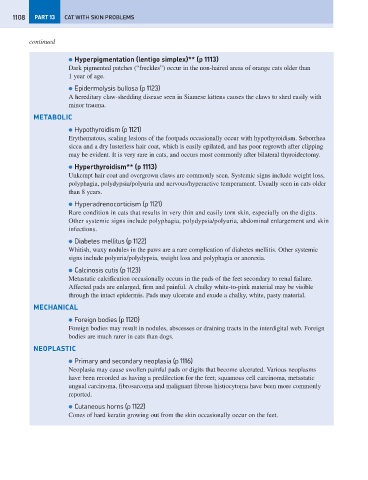Page 1116 - Problem-Based Feline Medicine
P. 1116
1108 PART 13 CAT WITH SKIN PROBLEMS
continued
● Hyperpigmentation (lentigo simplex)** (p 1113)
Dark pigmented patches (“freckles”) occur in the non-haired areas of orange cats older than
1 year of age.
● Epidermolysis bullosa (p 1123)
A hereditary claw-shedding disease seen in Siamese kittens causes the claws to shed easily with
minor trauma.
METABOLIC
● Hypothyroidism (p 1121)
Erythematous, scaling lesions of the footpads occasionally occur with hypothyroidism. Seborrhea
sicca and a dry lusterless hair coat, which is easily epilated, and has poor regrowth after clipping
may be evident. It is very rare in cats, and occurs most commonly after bilateral thyroidectomy.
● Hyperthyroidism** (p 1113)
Unkempt hair coat and overgrown claws are commonly seen. Systemic signs include weight loss,
polyphagia, polydypsia/polyuria and nervous/hyperactive temperament. Usually seen in cats older
than 8 years.
● Hyperadrenocorticism (p 1121)
Rare condition in cats that results in very thin and easily torn skin, especially on the digits.
Other systemic signs include polyphagia, polydypsia/polyuria, abdominal enlargement and skin
infections.
● Diabetes mellitus (p 1122)
Whitish, waxy nodules in the paws are a rare complication of diabetes mellitis. Other systemic
signs include polyuria/polydypsia, weight loss and polyphagia or anorexia.
● Calcinosis cutis (p 1123)
Metastatic calcification occasionally occurs in the pads of the feet secondary to renal failure.
Affected pads are enlarged, firm and painful. A chalky white-to-pink material may be visible
through the intact epidermis. Pads may ulcerate and exude a chalky, white, pasty material.
MECHANICAL
● Foreign bodies (p 1120)
Foreign bodies may result in nodules, abscesses or draining tracts in the interdigital web. Foreign
bodies are much rarer in cats than dogs.
NEOPLASTIC
● Primary and secondary neoplasia (p 1116)
Neoplasia may cause swollen painful pads or digits that become ulcerated. Various neoplasms
have been recorded as having a predilection for the feet; squamous cell carcinoma, metastatic
ungual carcinoma, fibrosarcoma and malignant fibrous histiocytoma have been more commonly
reported.
● Cutaneous horns (p 1122)
Cones of hard keratin growing out from the skin occasionally occur on the feet.

